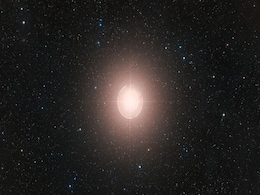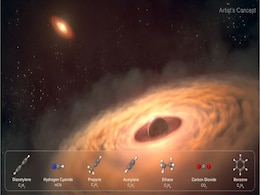Orbit Stars
- All
- News
- Videos
-

New Orbital Clues Reveal How Hot Jupiters Moved Close to Their Stars
- Tuesday December 16, 2025
Researchers reveal some hot Jupiters drifted inward smoothly through protoplanetary disks, offering clues to planetary system formation and stability.
-
 www.gadgets360.com
www.gadgets360.com
-

NASA Finds Thick Atmosphere On Rare Rocky Exoplanet
- Monday December 15, 2025
- Science |
Scientists are now analysing the entire data in depth to create a complete map of the temperature around the planet and better understand the composition of its atmosphere.
-
 www.ndtv.com
www.ndtv.com
-

JWST Detects Thick Atmosphere on Ultra-Hot Rocky Exoplanet TOI-561 b
- Sunday December 14, 2025
Astronomers using the James Webb Space Telescope have discovered compelling evidence of a thick atmosphere surrounding TOI-561 b, an ultra-hot rocky exoplanet orbiting its star every 11 hours. Despite extreme radiation and molten surface conditions, the planet appears cooler than expected, suggesting heat-redistributing atmospheric winds and volati...
-
 www.gadgets360.com
www.gadgets360.com
-

Astronomers Observe Star’s Wobbling Orbit, Confirming Einstein’s Frame-Dragging
- Friday December 12, 2025
Astronomers have detected a remarkable wobble in the orbit of a star being torn apart by a black hole, offering one of the clearest confirmations yet of Einstein’s frame-dragging effect. By tracking repeating X-ray and radio signals every 20 days, researchers captured spacetime twisting around a rapidly spinning black hole—revealing powerful in...
-
 www.gadgets360.com
www.gadgets360.com
-

TRAPPIST-1e Methane Signal Likely False, Webb Data Suggests Airless Planet
- Thursday December 11, 2025
The TRAPPIST-1 planetary system, located about 39 light-years from Earth, hosts seven rocky worlds orbiting a cool red dwarf star. While several of these Earth-sized planets lie in the star’s habitable zone, new observations from the James Webb Space Telescope suggest their atmospheres may be too thin to support life. Earlier hints of methane aro...
-
 www.gadgets360.com
www.gadgets360.com
-

Misaligned Exoplanet Is Challenging How We Think Solar Systems Form
- Friday December 5, 2025
Astronomers studying the dwarf-star system TOI-3884b have uncovered a striking anomaly: the planet’s orbit is sharply misaligned with its star’s rotation. Using multicolour transit observations, researchers detected repeated starspot-crossing events that revealed the planet passes over cooler regions on the stellar surface. Follow-up monitoring...
-
 www.gadgets360.com
www.gadgets360.com
-

NASA Shares Highly-Anticipated Images Of 3I/ATLAS, Reveals Details Of Mysterious Interstellar Comet
- Thursday November 20, 2025
- Science |
3I/ATLAS offers a rare chance to study material that has travelled billions of kilometres because it originates from another star system.
-
 www.ndtv.com
www.ndtv.com
-

Nearby Super-Earth GJ 251 c Could Help Learn About Worlds That Once Supported Life, Astronomers Say
- Sunday November 16, 2025
Astronomers discovered GJ 251 c, a super-Earth 20 light-years away. Its location in the habitable zone and rocky composition make it a top candidate for future searches for life beyond our solar system. The team, led by Suvrath Mahadevan and Corey Beard, said this discovery provides a clock for one of the best candidates to search for life's atmo...
-
 www.gadgets360.com
www.gadgets360.com
-

Astronomers Stunned By Three Earth-Sized Planets In Distant Unique Planetary System
- Wednesday October 29, 2025
- Science |
The study revealed that TOI-2267 has two closely bound stars orbiting each other, and the third planet transits the companion star.
-
 www.ndtv.com
www.ndtv.com
-

Newly Found ‘Super-Earth’ GJ 251 c Could Be One of the Most Promising Worlds for Alien Life
- Sunday October 26, 2025
A new super-Earth, GJ 251 c, has been found orbiting a nearby red dwarf star within its habitable zone. About four times Earth’s mass, it may host liquid water. Detected via the radial-velocity method using Penn State’s Habitable Zone Planet Finder, it’s a prime target in the search for life.
-
 www.gadgets360.com
www.gadgets360.com
-

NASA Telescopes Capture First-Ever Companion Star Orbiting Massive Red Supergiant Betelgeuse
- Sunday October 26, 2025
Astronomers have detected a small companion star orbiting the red supergiant Betelgeuse using Hubble and Chandra observations. Dubbed “Betelbuddy,” the discovery reveals an extreme binary system that challenges existing models of stellar evolution and may offer clues to Betelgeuse’s future.
-
 www.gadgets360.com
www.gadgets360.com
-

Kepler and TESS Discoveries Help Astronomers Confirm Over 6,000 Exoplanets Orbiting Other Stars
- Saturday December 13, 2025
More than 6,000 exoplanets (planets orbiting other stars), one of the most rapidly expanding frontiers in science, have now been confirmed by astronomers. Their search of other worlds has been transformed within a span of thirty years, which started as a form of speculation, to accurate detection. However, in the midst of this wave of discoveries, ...
-
 www.gadgets360.com
www.gadgets360.com
-

James Webb Offers First Glimpse Into How Moons Are Built Around Distant Planets
- Wednesday October 1, 2025
The James Webb Space Telescope has detected carbon-bearing molecules in a moon-forming disk surrounding CT Cha b, a massive planet-like object orbiting a young star 625 light-years away. The discovery marks the first measurement of its kind and offers clues to how moons like those around Jupiter and Saturn might have formed.
-
 www.gadgets360.com
www.gadgets360.com
-

New Orbital Clues Reveal How Hot Jupiters Moved Close to Their Stars
- Tuesday December 16, 2025
Researchers reveal some hot Jupiters drifted inward smoothly through protoplanetary disks, offering clues to planetary system formation and stability.
-
 www.gadgets360.com
www.gadgets360.com
-

NASA Finds Thick Atmosphere On Rare Rocky Exoplanet
- Monday December 15, 2025
- Science |
Scientists are now analysing the entire data in depth to create a complete map of the temperature around the planet and better understand the composition of its atmosphere.
-
 www.ndtv.com
www.ndtv.com
-

JWST Detects Thick Atmosphere on Ultra-Hot Rocky Exoplanet TOI-561 b
- Sunday December 14, 2025
Astronomers using the James Webb Space Telescope have discovered compelling evidence of a thick atmosphere surrounding TOI-561 b, an ultra-hot rocky exoplanet orbiting its star every 11 hours. Despite extreme radiation and molten surface conditions, the planet appears cooler than expected, suggesting heat-redistributing atmospheric winds and volati...
-
 www.gadgets360.com
www.gadgets360.com
-

Astronomers Observe Star’s Wobbling Orbit, Confirming Einstein’s Frame-Dragging
- Friday December 12, 2025
Astronomers have detected a remarkable wobble in the orbit of a star being torn apart by a black hole, offering one of the clearest confirmations yet of Einstein’s frame-dragging effect. By tracking repeating X-ray and radio signals every 20 days, researchers captured spacetime twisting around a rapidly spinning black hole—revealing powerful in...
-
 www.gadgets360.com
www.gadgets360.com
-

TRAPPIST-1e Methane Signal Likely False, Webb Data Suggests Airless Planet
- Thursday December 11, 2025
The TRAPPIST-1 planetary system, located about 39 light-years from Earth, hosts seven rocky worlds orbiting a cool red dwarf star. While several of these Earth-sized planets lie in the star’s habitable zone, new observations from the James Webb Space Telescope suggest their atmospheres may be too thin to support life. Earlier hints of methane aro...
-
 www.gadgets360.com
www.gadgets360.com
-

Misaligned Exoplanet Is Challenging How We Think Solar Systems Form
- Friday December 5, 2025
Astronomers studying the dwarf-star system TOI-3884b have uncovered a striking anomaly: the planet’s orbit is sharply misaligned with its star’s rotation. Using multicolour transit observations, researchers detected repeated starspot-crossing events that revealed the planet passes over cooler regions on the stellar surface. Follow-up monitoring...
-
 www.gadgets360.com
www.gadgets360.com
-

NASA Shares Highly-Anticipated Images Of 3I/ATLAS, Reveals Details Of Mysterious Interstellar Comet
- Thursday November 20, 2025
- Science |
3I/ATLAS offers a rare chance to study material that has travelled billions of kilometres because it originates from another star system.
-
 www.ndtv.com
www.ndtv.com
-

Nearby Super-Earth GJ 251 c Could Help Learn About Worlds That Once Supported Life, Astronomers Say
- Sunday November 16, 2025
Astronomers discovered GJ 251 c, a super-Earth 20 light-years away. Its location in the habitable zone and rocky composition make it a top candidate for future searches for life beyond our solar system. The team, led by Suvrath Mahadevan and Corey Beard, said this discovery provides a clock for one of the best candidates to search for life's atmo...
-
 www.gadgets360.com
www.gadgets360.com
-

Astronomers Stunned By Three Earth-Sized Planets In Distant Unique Planetary System
- Wednesday October 29, 2025
- Science |
The study revealed that TOI-2267 has two closely bound stars orbiting each other, and the third planet transits the companion star.
-
 www.ndtv.com
www.ndtv.com
-

Newly Found ‘Super-Earth’ GJ 251 c Could Be One of the Most Promising Worlds for Alien Life
- Sunday October 26, 2025
A new super-Earth, GJ 251 c, has been found orbiting a nearby red dwarf star within its habitable zone. About four times Earth’s mass, it may host liquid water. Detected via the radial-velocity method using Penn State’s Habitable Zone Planet Finder, it’s a prime target in the search for life.
-
 www.gadgets360.com
www.gadgets360.com
-

NASA Telescopes Capture First-Ever Companion Star Orbiting Massive Red Supergiant Betelgeuse
- Sunday October 26, 2025
Astronomers have detected a small companion star orbiting the red supergiant Betelgeuse using Hubble and Chandra observations. Dubbed “Betelbuddy,” the discovery reveals an extreme binary system that challenges existing models of stellar evolution and may offer clues to Betelgeuse’s future.
-
 www.gadgets360.com
www.gadgets360.com
-

Kepler and TESS Discoveries Help Astronomers Confirm Over 6,000 Exoplanets Orbiting Other Stars
- Saturday December 13, 2025
More than 6,000 exoplanets (planets orbiting other stars), one of the most rapidly expanding frontiers in science, have now been confirmed by astronomers. Their search of other worlds has been transformed within a span of thirty years, which started as a form of speculation, to accurate detection. However, in the midst of this wave of discoveries, ...
-
 www.gadgets360.com
www.gadgets360.com
-

James Webb Offers First Glimpse Into How Moons Are Built Around Distant Planets
- Wednesday October 1, 2025
The James Webb Space Telescope has detected carbon-bearing molecules in a moon-forming disk surrounding CT Cha b, a massive planet-like object orbiting a young star 625 light-years away. The discovery marks the first measurement of its kind and offers clues to how moons like those around Jupiter and Saturn might have formed.
-
 www.gadgets360.com
www.gadgets360.com

















